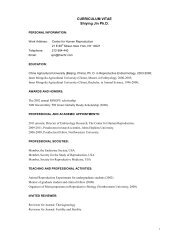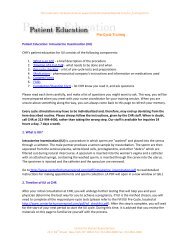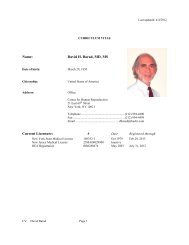CHR VOICE Winter 08.indd - Center for Human Reproduction
CHR VOICE Winter 08.indd - Center for Human Reproduction
CHR VOICE Winter 08.indd - Center for Human Reproduction
You also want an ePaper? Increase the reach of your titles
YUMPU automatically turns print PDFs into web optimized ePapers that Google loves.
Dr. Gleicher Gives the Prestigious Patrick Steptoe Memorial Lecture<br />
As we reported in the last issue of the <strong>VOICE</strong>, <strong>CHR</strong>’s Founder<br />
and Medical Director, Norbert Gleicher, MD, was invited to<br />
give the 2009 Patrick Steptoe Memorial Lecture to the<br />
British Fertility Society on January 7, 2009. We are happy<br />
to report here that Dr. Gleicher’s lecture on<br />
the assisted reproductive technologies was<br />
met with great interest and enthusiasm, but<br />
also stirred up some controversy, perhaps<br />
because his argument that infertility<br />
patients are entitled to maximal IVF<br />
pregnancy rates is not as widely embraced<br />
in Europe as it deserves. (For a list of media<br />
coverage of Dr. Gleicher’s BFS lecture, visit<br />
www.<strong>Center</strong>For<strong>Human</strong>Reprod.com/about_<br />
events.html.)<br />
While, on first impression, the answer to the<br />
question “are patients entitled to maximal<br />
pregnancy rates” may seem like a very<br />
obvious one, considering some recent<br />
developments, it really isn’t. Take, <strong>for</strong><br />
example, the widely propagated concept<br />
of preimplantation genetic screening (PGS) in attempts<br />
to improve IVF outcomes and reduce miscarriage rates.<br />
While <strong>CHR</strong>’s investigators <strong>for</strong> years have been making<br />
the argument that PGS may achieve these goals only in<br />
carefully selected cases, and in a majority of situations may<br />
actually reduce IVF pregnancy chances 1 , PGS was widely<br />
touted and freely integrated into routine IVF practice by<br />
many IVF centers. Indeed, only after a prospective Dutch<br />
study demonstrated lower IVF pregnancy rates after PGS 2 ,<br />
did regulatory bodies suddenly wake up and start to speak<br />
out against the uncontrolled utilization of PGS.<br />
Other examples of new IVF modifications abound; invariably<br />
they come with no proven benefits but are characterized<br />
by adverse effects on pregnancy chances. They are<br />
hoisted upon a largely unin<strong>for</strong>med, or misin<strong>for</strong>med, public<br />
without proper in<strong>for</strong>med consents, simply because they are<br />
considered “worthwhile” by some. One such procedure,<br />
to which we have continuously opposed, is the routine<br />
single embryo transfer (s-ET). Like PGS, s-ET reduces<br />
pregnancy chances per embryo transfer without offering<br />
significant benefits in return. <strong>CHR</strong> investigators recently<br />
demonstrated this fact in a number of publications 3,4,5 . Yet,<br />
s-ET is still being widely propagated.<br />
As the concept of s-ET has taken hold in Europe (and is now,<br />
though to a lesser degree, increasingly also propagated<br />
here in the U.S.), European investigators now seem to<br />
develop other “brilliant” ideas with negative connotations<br />
<strong>for</strong> IVF pregnancy rates almost non-stop.<br />
The latest fashion is so-called patientfriendly<br />
IVF, an euphemism generally<br />
used to describe IVF cycles with either<br />
no medical stimulation (natural cycle<br />
IVF) or only mild ovarian stimulation (mild<br />
stimulation IVF). The only thing all of<br />
these <strong>for</strong>ms of IVF really have in common<br />
is that they result in awfully low pregnancy<br />
rates. What is so “patient-friendly” in low<br />
pregnancy rates, we here at <strong>CHR</strong> fail to<br />
understand. By implication, traditional<br />
IVF would then have to be called “patientunfriendly.”<br />
We take this <strong>for</strong>m of IVF,<br />
however, any day of the year over the<br />
more “patient-friendly” <strong>for</strong>ms of IVF, as<br />
long as our patients conceive quicker, and<br />
by extension, <strong>for</strong> lower costs.<br />
In our opinion, many women nowadays simply do not get<br />
maximal IVF treatment, worth their hard-earned dollars.<br />
Because most of these pseudo-innovations come from<br />
Europe, one cannot be surprised that European pregnancy<br />
rates are dramatically lower than those in the U.S., a fact<br />
first brought to the public’s attention by Drs. Gleicher,<br />
Weghofer and Barad in 2006 and 2007 6,7 .<br />
This questionable trend in contemporary IVF practices,<br />
of course, explains why we at <strong>CHR</strong> continue to fight <strong>for</strong><br />
maximal pregnancy rates <strong>for</strong> infertility patients. A question<br />
with a seemingly very obvious answer, quite clearly, no<br />
longer is that obvious!<br />
1<br />
Gleicher et al., Fertil Steril, 2008;89:780-8.<br />
2<br />
Mastenbroek et al., N Engl J Med 2007;357:9-17.<br />
3<br />
Gleicher and Barad, Fertil Steril 2008; doi:10.1016/<br />
j.fertnstert.2008.02.160<br />
4<br />
Gleicher and Barad, Expert Rev Obstet Gynecol 2008;<br />
doi10.1586/17474108.3.4.xx<br />
5<br />
Gleicher and Barad, Gynecol Obstet 2008;13: 77-83<br />
6<br />
Gleicher et al., Hum Reprod 2006;21:1945-50<br />
7<br />
Gleicher et al., Fertil Steril 2007;87:1301-5
Breaking New Ground: <strong>CHR</strong> in Research and Education<br />
First-Ever Grandrounds<br />
on Fertility Preservation<br />
AMH a Better Tool to Assess<br />
Ovarian Reserve than FSH<br />
As most of our readers know, postgraduate medical<br />
education is one of <strong>CHR</strong>’s major dedications, best<br />
demonstrated by regular Grandrounds, which <strong>for</strong> many<br />
years <strong>CHR</strong> has been sponsoring<br />
in collaboration with the<br />
Foundation <strong>for</strong> Reproductive<br />
Medicine (FRM) <strong>for</strong> the Ob/Gyn<br />
community of physicians. Fully<br />
certified to award continuing<br />
medical education (CME) credits<br />
by the ACCME, <strong>CHR</strong> has made<br />
these events the best attended<br />
Grandrounds in the specialty in<br />
New York City.<br />
Our very rapid growth in fertility<br />
preservation in 2008, however,<br />
mandates an expansion of targeted physician populations<br />
<strong>for</strong> our Grandrounds. Since obstetrician/gynecologists are<br />
usually not the ones to diagnose malignancies in young<br />
females, our postgraduate educational activities have<br />
to expand to those medical specialties that do. This, of<br />
course, primarily includes pediatric and adult oncologists,<br />
but also oncologic surgeons, hematologists and even<br />
rheumatologists. All of these specialties routinely face<br />
clinical situations that <strong>for</strong>ce them to administer treatments,<br />
which affect female and male fertility potential. We now see<br />
it as our added responsibility to educate colleagues in<br />
all of these specialties about the availability and timesensitivity<br />
of fertility-preserving techniques <strong>for</strong> their<br />
patients.<br />
A first very successful <strong>CHR</strong> Grandrounds event <strong>for</strong> non-<br />
Ob/Gyns was held on September 23, 2008, with Dr.<br />
Kutluk Oktay (pictured here) presenting a general update<br />
on fertility preservation. Future events are in the planning<br />
stages <strong>for</strong> the new year 2009 as well; stay tuned!<br />
In 2008, <strong>CHR</strong> researchers made great progress in the use<br />
of Anti-Müllerian Hormone (AMH) as a tool in assessing<br />
ovarian reserve. Here, research led by Drs. David Barad<br />
(pictured here) and Kutluk Oktay<br />
in two independent areas led to<br />
surprisingly similar conclusions:<br />
Dr. Barad has been investigating<br />
how well AMH could predict<br />
ovarian per<strong>for</strong>mance in IVF. He<br />
and his co-investigators were able<br />
to demonstrate that AMH was a<br />
much better predictor of oocytes<br />
(egg) yield and pregnancy rates<br />
than follicles stimulating hormone<br />
(FSH), but these predictive<br />
abilities were much better in<br />
normally functioning ovaries than<br />
in ovaries with diminished ovarian reserve (Barad et al.<br />
Fertil Steril; in press).<br />
Dr. Oktay in parallel investigated the use of AMH in women<br />
who had received chemotherapy <strong>for</strong> various cancers.<br />
Chemotherapy, of course, greatly affects ovarian function<br />
and, indeed, can put patients into full menopause. He and<br />
his co-investigators also were able to confirm that AMH<br />
correlates very well with ovarian function; but, like Dr.<br />
Barad in regular infertility patients, Dr. Oktay demonstrated<br />
that the ability of AMH to reflect ovarian function decreases<br />
as ovarian function becomes abnormal, in this case as a<br />
consequence of chemotherapy. (A manuscript has been<br />
submitted <strong>for</strong> publication.)<br />
Both studies suggest that AMH under normal circumstances<br />
is probably a better indicator of ovarian function than FSH,<br />
but loses this ability as ovarian function becomes abnormal.<br />
These findings furthermore suggest that AMH can also be<br />
used as a parameter to assess egg quality.<br />
Our Continued Work on DHEA Receives World-Wide Response<br />
Aside from the fact that <strong>CHR</strong> physicians broke all records at last year’s ASRM meeting with twelve presentations, bringing<br />
the <strong>CHR</strong> to the top one percent of all the world institutions in visibility, one of the most satisfying moments was when we<br />
received feedback from colleagues from all over the world. These physicians, in previously unprecedented numbers, now<br />
have embraced the dehydroepiandrosterone (DHEA) protocol, developed at <strong>CHR</strong> <strong>for</strong> women with diminished ovarian<br />
reserve, elevated FSH levels and/or simply advanced female age. Both Dr. Barad and Dr. Gleicher were approached<br />
by physicians from many different countries, who wanted to share their “DHEA success stories.”<br />
At the ASRM meeting, Dr. Ed Ryan from Toronto, Canada, who had previously collaborated with <strong>CHR</strong> on a report on<br />
decreased miscarriage rates after DHEA supplementation (the abstract was presented at the 2006 ASRM Meeting and<br />
a manuscript is in preparation), reported his center’s gender experience after DHEA supplementation. Like we here at<br />
<strong>CHR</strong>, he has observed a considerable shift towards male offspring. This was also the observation made by Dr. Mamas,<br />
an investigator from Athens, Greece, who this year reported his center’s DHEA success in Fertility and Sterility. He<br />
communicated his center’s gender finding in a conversation with Dr. Gleicher. It appears that <strong>CHR</strong>’s initial observation<br />
that DHEA supplementation shifts the gender balance towards more males may, indeed, be correct.
Breaking New Ground: <strong>CHR</strong> in Clinical Care<br />
<strong>CHR</strong>’s Ef<strong>for</strong>t in Identifying POA Risk Factors Extends Hope<br />
Investigators at <strong>CHR</strong> recently identified two high risk groups <strong>for</strong> premature ovarian aging<br />
(POA): women with abnormal triple CGG counts on the FMR1 (fragile X) gene and women<br />
with abnormal autoimmune function (Gleicher et al., Fertil Steril doi:10.1016/j.fertnstert.200<br />
8.01.098. and Gleicher et al., Fertil Steril doi:10.1016/j.fertnstert.2008.01.099). The FMR1<br />
gene, in particular, has been one of the main targets of research at <strong>CHR</strong> <strong>for</strong> about two<br />
years, and we have made considerable progress.<br />
In brief, the number of CGG repeats on this gene directly relates to the risk of developing<br />
premature ovarian failure (POF). While this has been known <strong>for</strong> some time, we were the<br />
first to demonstrate that not only POF relates to excessively high CGG repeats, but milder<br />
<strong>for</strong>ms of ovarian senescence (premature ovarian aging; POA) do so as well. Moreover,<br />
we have been able to confirm that the risk <strong>for</strong> POF and POA increases as the repeat counts<br />
deviate further from the apparent norm (29-30 repeats) in either direction (high or low<br />
counts). These findings have an obvious clinical significance: in addition to more accurately<br />
diagnosing infertility, we may be able to predict the future fertility of young women.<br />
Risk <strong>for</strong> POA, of course, does not denote that everybody will develop POA. Young women<br />
identified to be at risk should, however, be carefully monitored. Annual ovarian function tests<br />
with FSH and AMH evaluations, if done age-specific, will allow <strong>for</strong> the early identification<br />
of those who really are developing POA. For such women fertility preservation may then<br />
represent a very good idea.<br />
It goes without saying that the younger she is at the time of fertility preservation, the better<br />
the result. This is important to recognize because the younger the eggs are at the time of<br />
cryopreservation, the higher their pregnancy chances, once they are thawed out, whether<br />
as eggs or embryos.<br />
POA can be familial. In other words, daughters of women who experienced early menopause<br />
(normal age is ca. 52), are also at an increased risk <strong>for</strong> early menopause. A history of early<br />
menopause usually reflects a history of POA. Since women in past generations had children<br />
at much younger ages, POA did not represent as much of a clinical infertility problem as it<br />
does today. Women who experienced early menopause are, there<strong>for</strong>e, well advised to<br />
encourage their daughters to have their ovarian functions tested at relatively young<br />
ages. With the addition of the Institute <strong>for</strong> Fertility Preservation, <strong>CHR</strong> is now in an excellent<br />
position to offer future fertility options <strong>for</strong> young women who are identified as carrying high<br />
risk of developing POA later in life.<br />
No Need to Break That Piggy Bank!<br />
In view of recent world-wide economic events, we in 2009 expect<br />
to see significant differences from prior years: In difficult economic<br />
times, even those lucky enough to maintain their employment often<br />
see benefits cut. Often, amongst the first to go are fertility or even<br />
general medical benefits. We, there<strong>for</strong>e, anticipate that many amongst<br />
our patients will financially be even more challenged by the significant<br />
expenses of fertility treatments this year, and are committed to assist<br />
wherever and whenever we can be of help.<br />
This may, there<strong>for</strong>e, be the right time to remind our patients of our income-based discount<br />
program. In consideration of the high costs of infertility treatments, <strong>CHR</strong> offers significant<br />
discounts on regular fees to patients/couples below a generous income ceiling. If you<br />
don’t have insurance coverage <strong>for</strong> fertility services, and if fertility treatments unreasonably<br />
stretch your financial resources, then speak to our staff. The front desk staff will advise you<br />
of our discount program and the clinical staff may be able to help you with the costs of fertility<br />
medications. There is nothing wrong with asking <strong>for</strong> help; we are here to help!<br />
Oldest Embryo Ever<br />
In the context of elective<br />
fertility preservation, we<br />
recently cryopreserved<br />
an embryo from a 49-year<br />
and 11-month old woman,<br />
which very likely is the<br />
“oldest” human embryo<br />
ever frozen. Indeed,<br />
we were unable to find<br />
evidence in literature that<br />
a human embryo was ever<br />
produced in a woman of<br />
this age. This, there<strong>for</strong>e,<br />
very likely, is not only the<br />
“oldest” human embryo<br />
ever cryopreserved, but<br />
also the “oldest” human<br />
embryo ever produced by<br />
a clinical fertility center.<br />
This patient came to<br />
us, while already in an<br />
ovarian stimulation cycle.<br />
We were able to retrieve<br />
one oocyte, which was<br />
normally fertilized. It, by<br />
day three after fertilization,<br />
progressed to a good<br />
quality embryo, fulfilling<br />
our center’s criteria <strong>for</strong><br />
cryopreservation.<br />
Based on her age and the<br />
potential negative effects<br />
of cryopreservation, she<br />
is fully aware of her small<br />
chances of conception.<br />
She has initiated DHEA<br />
treatment and is planning<br />
on further cycles, when<br />
her life as a mother of older<br />
children can accommodate<br />
pregnancy.
28 YEARS LEADING INFERTILITY CARE<br />
The <strong>Center</strong> <strong>for</strong> <strong>Human</strong> <strong>Reproduction</strong><br />
650 W. Lake Street<br />
Suite 200<br />
Chicago, IL 60661<br />
We’re on the Web!<br />
www.<strong>Center</strong>For<strong>Human</strong>Reprod.com<br />
Editors:<br />
Yu Kizawa • ykizawa@thechr.com<br />
Mark Dixon • mdixon@thechr.com<br />
Letter from a Patient: “Miracle” at Age 41<br />
I have a history of PCOS, endometriosis and high FSH that<br />
goes back to my teens. Four top infertility clinics told me I’d never<br />
have a baby without using a donor egg. However it was important<br />
to my husband and me that we do all we could to conceive a child<br />
that was part of both of us. That’s when we discovered <strong>CHR</strong> and<br />
met Dr. Gleicher and Dr. Barad. They started me on DHEA and<br />
I had two IVF sessions that failed because I was still unable to<br />
produce a viable egg. Then five months after starting DHEA, I<br />
was not feeling well and visited<br />
Dr. Barad who per<strong>for</strong>med a<br />
sonogram to investigate. He<br />
then discovered the cause of<br />
my “sickness”: I was pregnant!<br />
Somehow I’d spontaneously<br />
conceived. He and the nurses<br />
were stunned, and my husband<br />
and I were overwhelmed with<br />
joy. Lucas was born the day be<strong>for</strong>e my 41st birthday. He is 10<br />
months old now and I love being a Mom. The team at <strong>CHR</strong> were<br />
amazing! Everyone there, including the doctors, nurses and<br />
assistants, were caring, encouraging, and supportive. They are<br />
truly special people and helped us bring a miracle into our lives.<br />
–M.C.<br />
<strong>CHR</strong><br />
in the<br />
Media<br />
2008 was truly a remarkable year<br />
<strong>for</strong> the media’s attention to <strong>CHR</strong>.<br />
In July, Dr. Gleicher’s lecture on<br />
twin pregnancies at the ESHRE<br />
meeting stirred considerable<br />
controversy in the British press.<br />
Shortly thereafter, national news<br />
shows such as Today Show and<br />
Early Show prominently featured <strong>CHR</strong> doctors (Dr.<br />
Oktay <strong>for</strong> fertility preservation; Dr. Gleicher <strong>for</strong> DHEA).<br />
Media coverage of <strong>CHR</strong> was not limited to broadcast<br />
media: Newsweek ran a story on Dr. Oktay’s work<br />
on fertility preservation <strong>for</strong> cancer patients. Links to<br />
these media pieces are available at our website, www.<br />
<strong>Center</strong>For<strong>Human</strong>Reprod.com/about_events.html.<br />
With the realization that educating not only patients but<br />
also the public at large is critical to <strong>CHR</strong>’s mission,<br />
we are working on enhancing our presence in the<br />
audiovisual arena. Preliminary videos have already<br />
been posted on our website, and more are in the<br />
hatching <strong>for</strong> 2009. These video pieces, primarily on<br />
cutting-edge infertility treatments, are designed to<br />
educate the public in a manner more approacheable,<br />
perhaps, than written text.




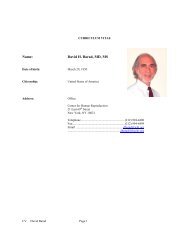
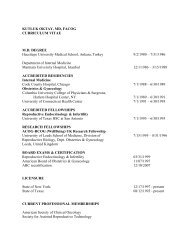

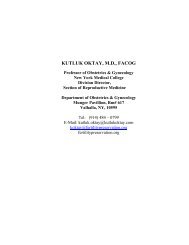

![Download Dr. Kushnir's Curriculum Vitae [PDF] - Center for Human ...](https://img.yumpu.com/31716705/1/190x245/download-dr-kushnirs-curriculum-vitae-pdf-center-for-human-.jpg?quality=85)
